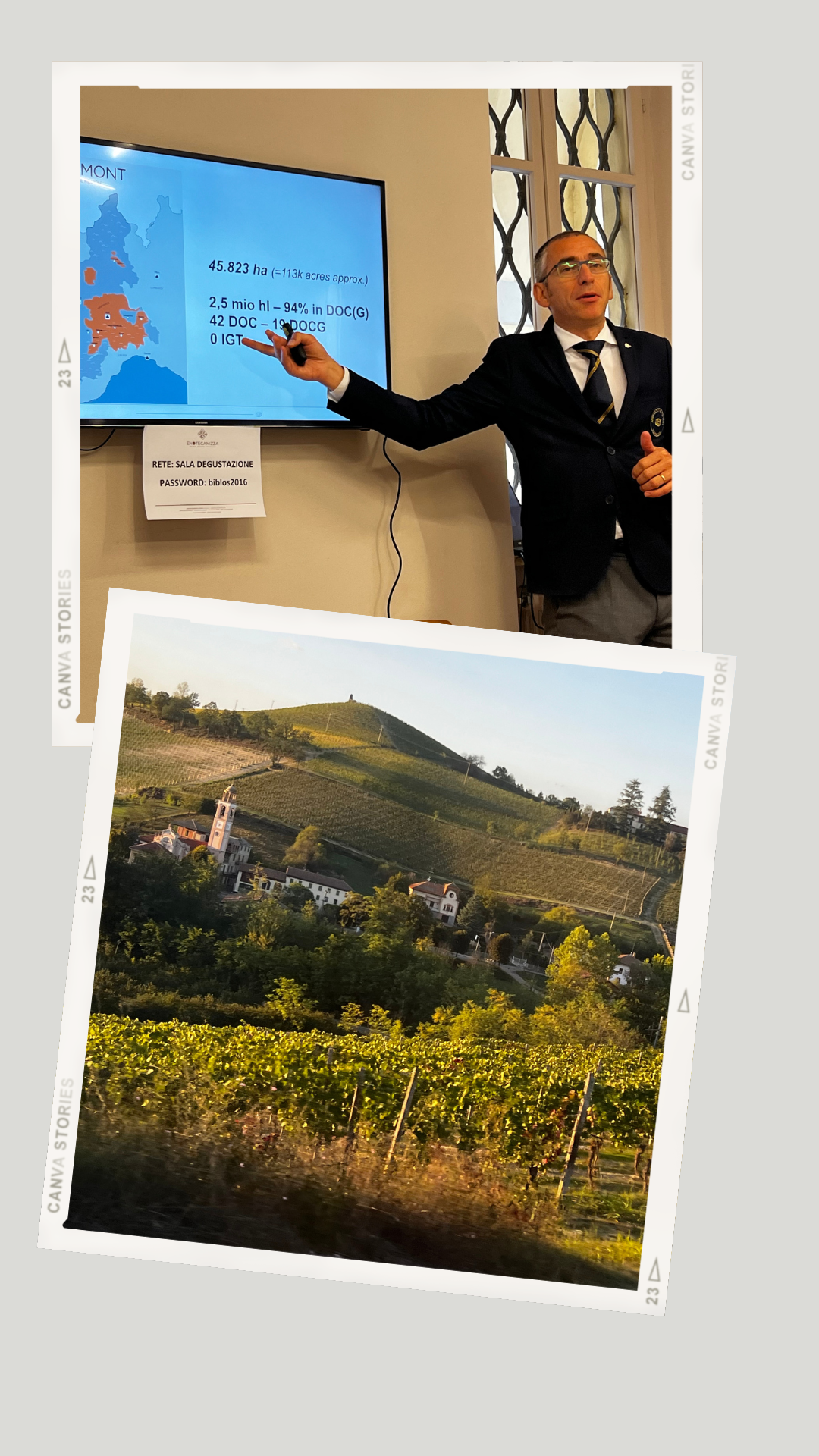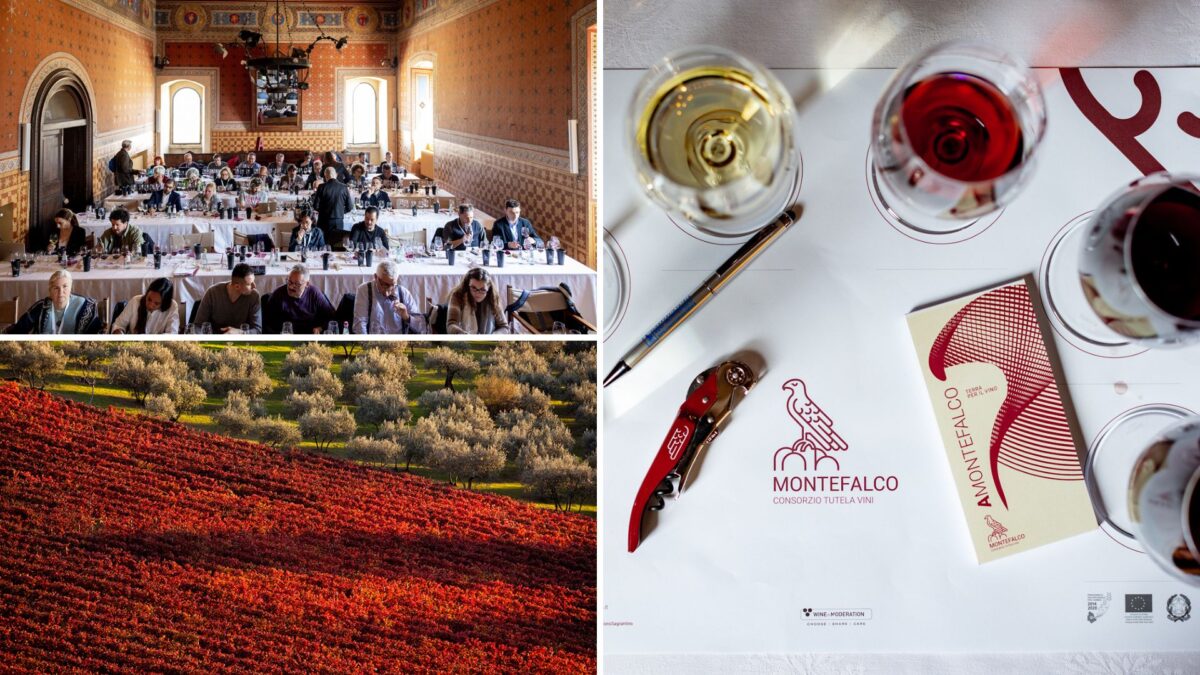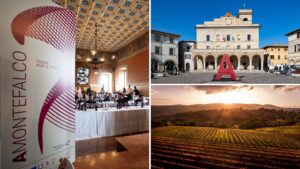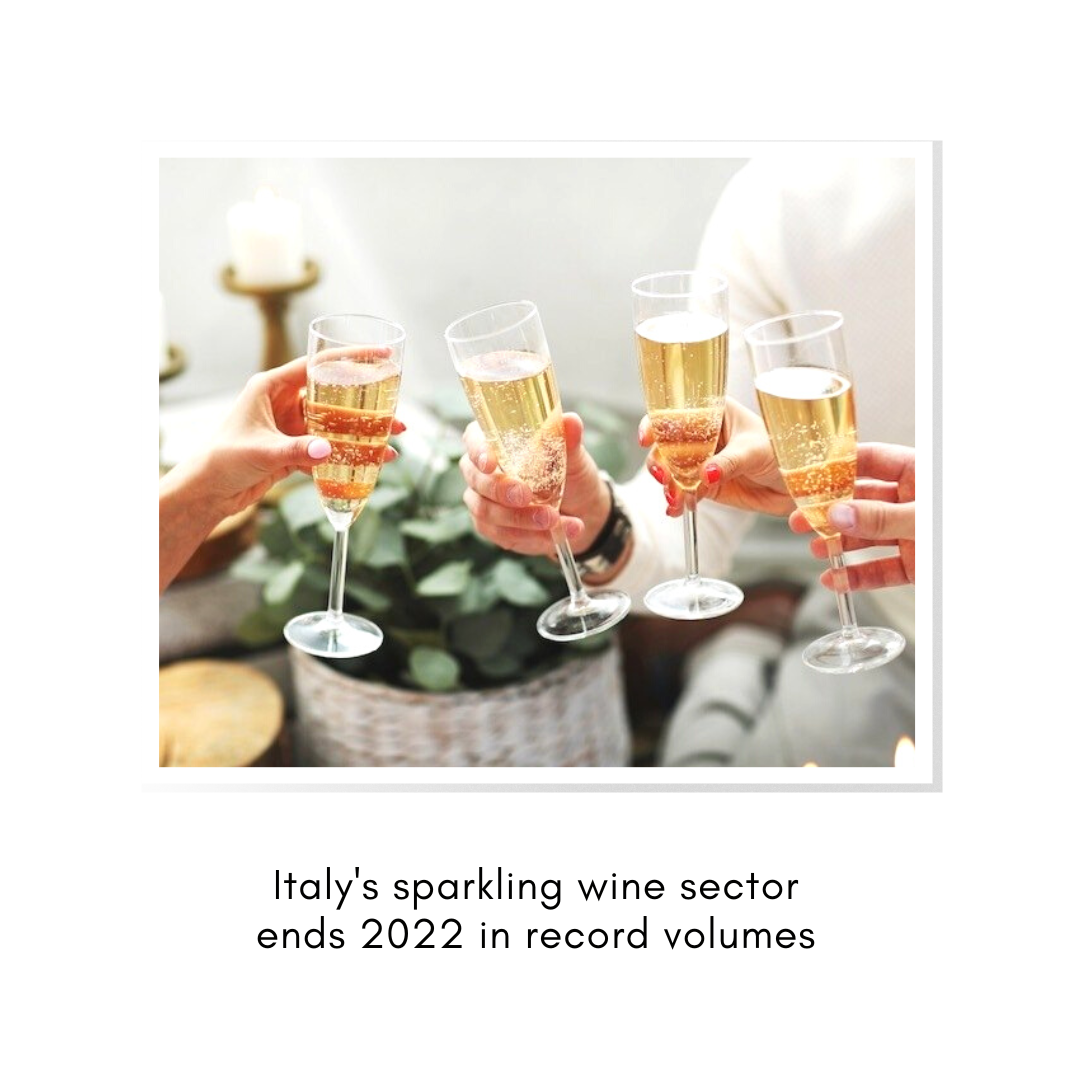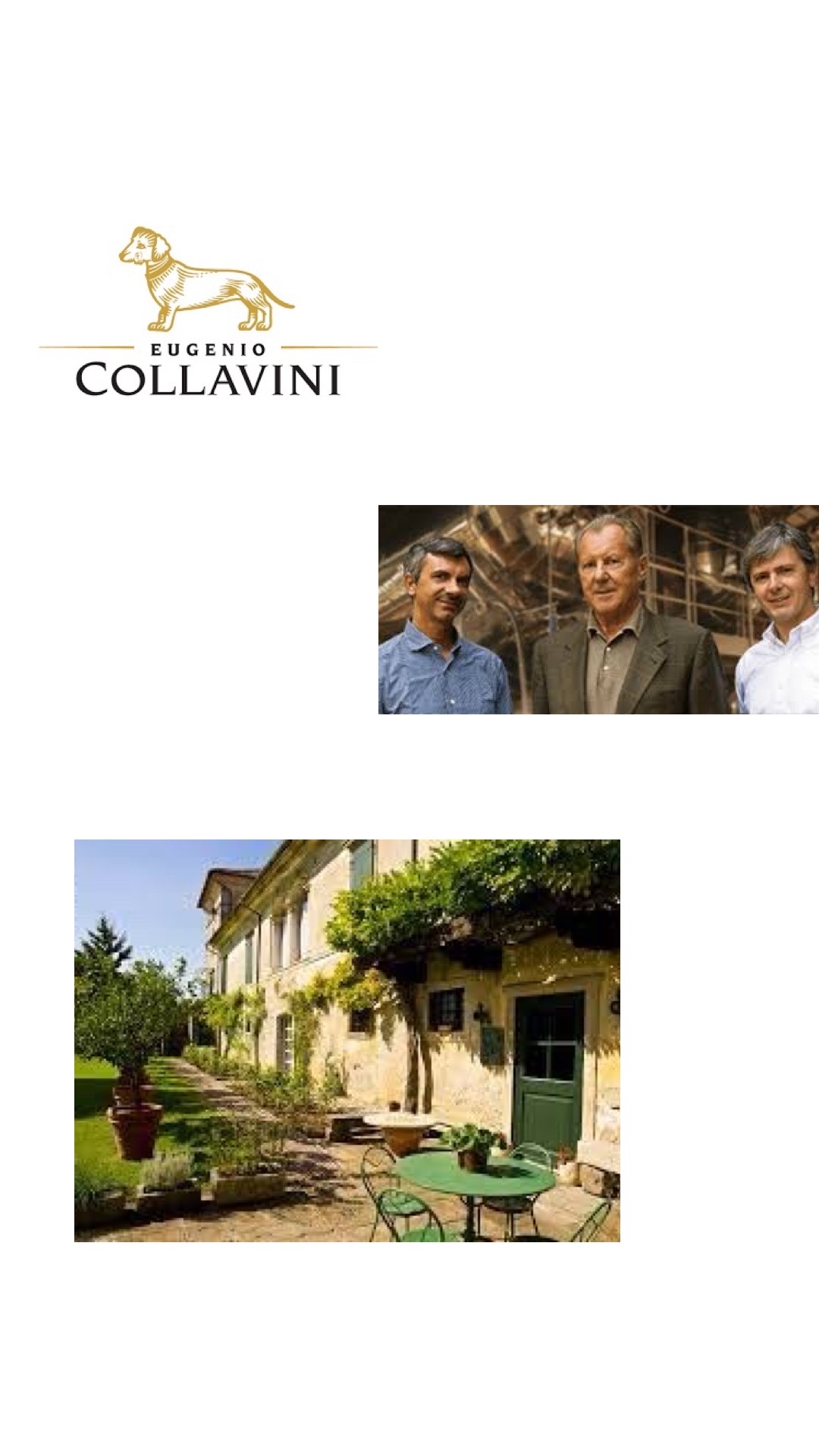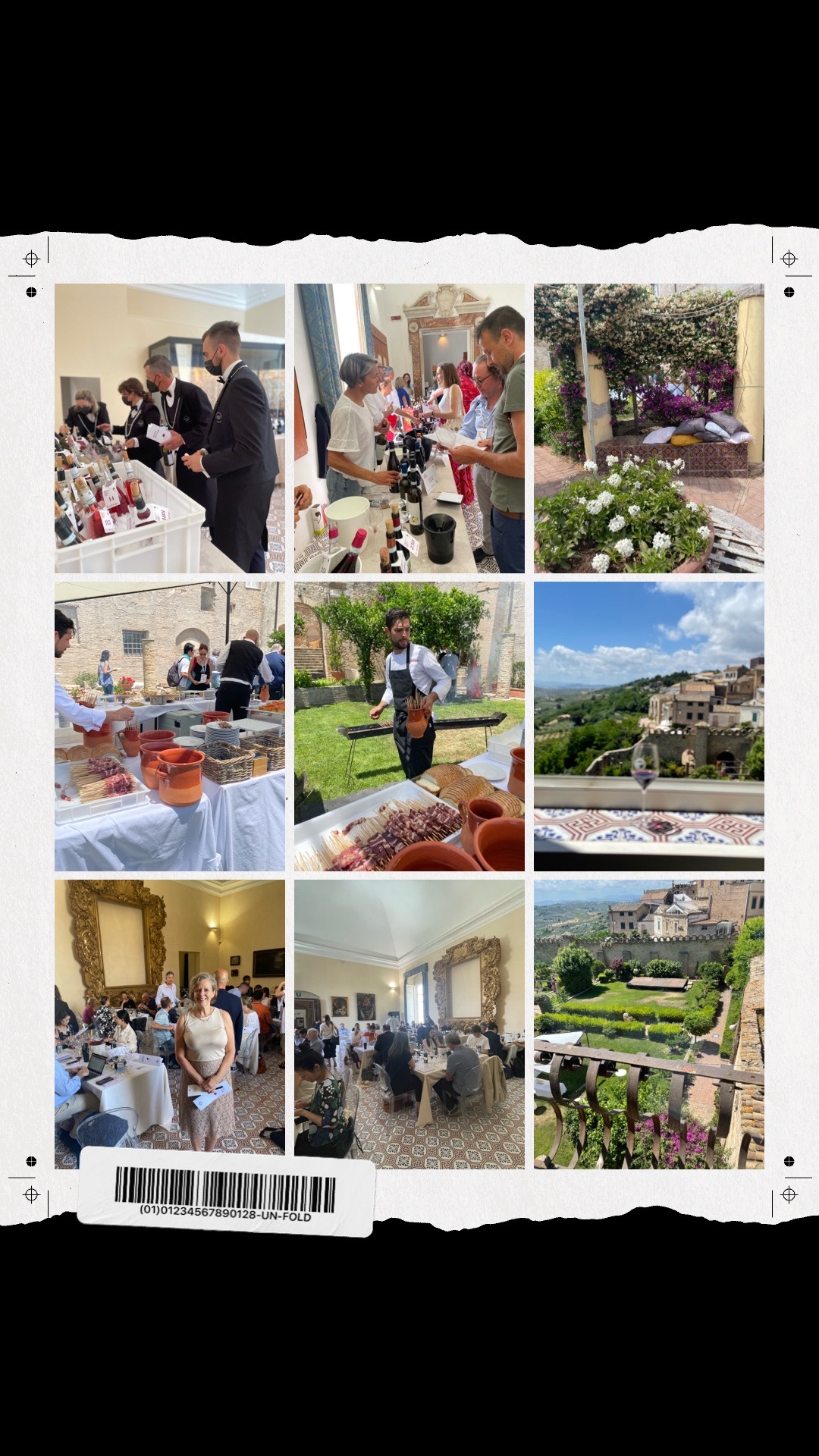This jewel of Piedmont became part of UNESCO’s World Heritage Sites in 2014. It is interesting to note, that this was the first time an Italian vineyard landscape “Monferrato, Piedmont” was recognized as having exceptional value by the UNESCO World Heritage Committee, and these landscapes were listed as such.
UNESCO states:
“are an exceptional living testimony to the historical tradition of grape cultivation, the processes for wine-making, a rural social context, and an economic fabric based on the culture of wine.”
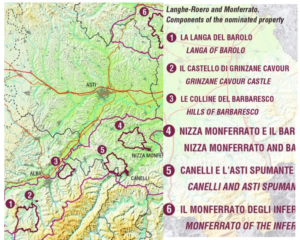
I was thrilled to learn more about this exceptional area. I attended a Masterclass, a few weeks ago, which was conducted by the very knowledgeable Andrea Dani, at Palazzo Crova. For history buffs, Palazzo Crova, is a stunning example of an 18th-century noble residence in this region.
Andrea, a member of Associazione Italiana Sommelier, conducted an overview on Barbera D’asti DOCG, Nizza DOCG and Ruchè di Castagnole Monferrato DOCG.
The Consortium
The Barbera d’Asti and Monferrato Wines Consortium was founded in 1946 to protect and promote its denominations, and their image, on national and international markets. Currently, the Consortium has more than 404 membered- companies and 13 protected denominations.
Filippo Mobrici, Vice President of Barbera d’Asti and Monferrato Wines Consortium, says:
“There are many wine souls that find expression in Monferrato, and the Consortium has had the objective, since its inception, precisely to act as a bond to keep these multiplicities united, to promote the entire territory and its excellence in a unitary and uniform way.”
Barbera
Barbera is a northern Italian grape that produces fresh, light-bodied red wines with low tannins. Like so many Italian wine grape varieties, Barbera has ancient origins that traces back to the 17th Century. Barbera was first cited in 1798, in a document, by Count Giuseppe Nuvolone-Pergamo of Scandaluzzo.
With this history, Barbera likely originated in Piedmont, the region for which it is well known. Alongside Barbera d’Alba DOC and Barbera d’Asti DOCG, the grape also gives its name to the Barbera del Monferrato DOC and Barbera del Monferrato Superiore DOCG titles – all in the Piedmont region.
The “Barbera” grape variety is also referred to as ‘La Barbera’, treating it in the feminine context. This variety is challenging to cultivate as it produces many shoots, therefore requiring regular pruning and low yields. Century-old vines still exist in many regional vineyards. It ripens relatively late, has a unique balance between sugar and acidity, and is a deep ruby colour.
General tasting notes include:
Lively and bright colours, intense fruit aromas, spicey notes, some toasted and balsamic notes, crunchy acidity, low tannins and excellent food pairing options
Barbera can also be found outside Piedmont: Oltrepò Pavese, Colli Piacentini, Franciacorta, Umbria, Campania, Puglia, Sicilia, and has been adopted by winegrowers around the world: California and South America.
The Soils of Monferrato
The soils on which Barbera and the other Monferrato grape varieties are grown date back to 2 million years ago. The sea began to leave the current Po Valley, initiating a process of landscape shaping that has characterized the change and the present-day conformation of the hills.
The soils, generally poor in organic matter, and often dry in summer, can be divided into two main types: white soils and Asti sands. White soils are more ancient and widespread in the Canelli area, southern Asti area, Alessandria area and the Casale area. The wines produced from these grapes are often full-bodied, rich in color, and are suitable for long aging. The sands of Asti soils spread mainly in the center of the Asti Monferrato area to the right and left of the Tanaro River and are found on much steeper hills. The wines produced from these grapes here are characterized by lower acidity, ripen faster, and are more for immediate consumption.
Climate
The Climate in this area is Continental with hot summers (+/- 35 degrees), some drought and cold winters ( -/+15 degrees). Rainfall between May and November is 700-800 mm/year.
Barbera D’Asti DOCG
Ancient farming traditions are representative in this area, which forms 116 municipalities in the province of Asti, and 51 municipalities in the province of Alessandria. 90% of Barbera is produced on the best-exposed hills of Asti and Monferrato. Barbera DOCG is usually harvested in the second half of September. Vinification is usually in steel, which produces fresher and more immediate wines, the use of barriques and barrels has developed, aimed at producing the Superiore which, tends to be more complex, and long-aging.
With respect to the organoleptic characteristics, the color is ruby-red, particularly intense in Superiore, tending towards garnet with aging. The aromas are intense: cherry, plum, dark berries prevail, which evolve into hints of jam, some balsamic, spicy, and floral notes. The taste is full, with great harmony. Aging often gives complexity and richness of velvet tannins and long taste-olfactory persistence.
Barbera D’Asti DOCG Timeline
1970 – Acquired DOC Barbera d’Asti
2008 – DOC Barbera d’Asti DOCG Barbera d’Asti. 3 subzones:
- Nizza
- Tinella
- Colli Astiani
2016 – Nizza DOCG (18 municipalities – Nizza Monferrato)
Production specifications include:
Territory: 167 municipalities in the province of Asti and Alessandria
Ampelography: min.90% Barbera grapes + 10% max other non-aromatic red grapes allowed in Piedmont
Yield: 9 ton/ha
Minimum natural alcohol content: 12%vol., 12.5%vol. Superiore
Minimum aging: 4 months – 14 months (Superiore, with min.6 in wood)
Nizza DOCG
Produced with only Barbera grapes, Nizza DOCG comes to life in the heart of Monferrato, in a production area that includes 18 municipalities. Nizza DOCG was in fact initially recognized as a sub-area of Barbera d’Asti and obtained its DOCG recognition in 2014.
These wines are usually aged for 18 months, of which 6 months in wooden barrels. Nizza DOCG is a wine characterized by intense aromas of cherry, plum and dark berries, which evolve into hints of jam, with some balsamic, spicy and floral notes. If aged in wood, the wine develops notes of cinnamon, cocoa and licorice. The taste is full, with great harmony. Aging gives complexity and richness of sweet and velvety tannins and long taste-olfactory persistence.
Nizza DOCG Timeline
1970 – DOC Barbera d’Asti
2000 – (vintage) Nizza as a subzone of the Barbera d’Asti Superiore Nizza
2008 – DOCG Barbera d’Asti
2014 – (vintage) Nizza DOCG (18 municipalities – Nizza Monferrato)
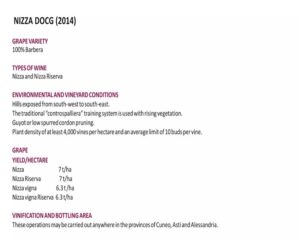
Ruchè di Castagnole Monferrato DOCG
It’s interesting to note, that the origin of the Ruchè varietal cannot be confirmed. Its history can be reconstructed of verbal traditions passed on from generation to generation.
Ruchè is one of the rarest native vines grown in the Asti Monferrato area, in calcareous, dry soils subject to great exposure to the sun. It obtained DOCG status in 2010 and its production now reaches one million bottles. Made with 90 to 100% Ruchè grapes (with Barbera and/or Brachetto grapes permitted up to a maximum of 10%), Ruchè di Castagnole Monferrato DOCG is distinguished by an intense and original bouquet, with floral and spicy notes, sometimes combined with hints of mixed berries and morello cherries. The flavor is dry, harmonious and pleasantly soft, with good aromatic persistence.
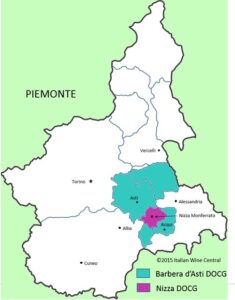 Wines of Barbera d’Asti & Monferrato
Wines of Barbera d’Asti & Monferrato
By the Numbers
404 associated companies
13 Protected designations
4 DOCGs:
Barbera d’Asti, Nizza, Ruchè di Castagnole Monferrato and Terre Alfieri
9 DOCs:
Albugnano, Cortese dell’Alto Monferrato, Dolcetto d’Asti, Freisa d’Asti, Grignolino d’Asti, Loazzolo, Malvasia di Castelnuovo Don Bosco, Monferrato, Piemonte
In the Vineyard
The area claimed by all the Designations of the Consortium in 2021 was equal to 10,430 hectares.
4,142 hectares claimed to Barbera d’Asti DOCG
3,827 hectares claimed to Piedmont DOC
In the Wine Cellar
As of 2021, the total amount of bottled wine registered by all protected Designations was equal to 492,986.21 hl for 65,731,495 bottles.
Barbera d’Asti DOCG: 149,689.70 hectoliters and 19,958,627 bottles
Piemonte DOC: 275,696.83 hectoliters and 36,759,577 bottles

